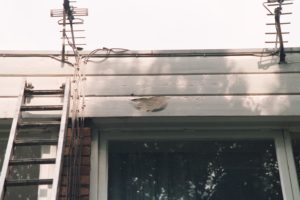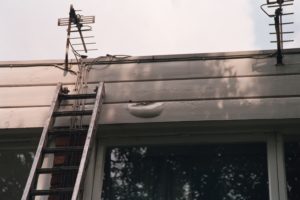

The early to mid-1970s was a boom time for our industry with the design and build concept being accepted by many local authorities. This surge in building has now brought many problems, largely associated with the type and nature of the building materials used along with the basic design of the various components, such as windows. The component parts of these modular type buildings – mainly schools and housing – were in many cases part assembled in the factory and transported to site. This procedure resulted in the cavity membrane and insulation being disturbed. This also applied to the earlier timber framed dwellings that are now quite commonplace.
Although many of these buildings were subsequently cladded with traditional materials such as brick, sand/cement render or wood, the moisture created internally can still be absorbed into the interior surface and transferred through to the exterior surface.
If we look at the joinery and in particular the window design, we can see that the detail of the various components have gone from having a good rebate with arises rounded off to sections that are almost level. This is particularly noticeable with the window cills having gone away from a good rounded nose to almost square angles.
we encounter are of poor design with no proper sealant being used before fixing the glazing beads and wire nails which are inclined to corrode have been used in place of brass screws. Consequently water ingress readily occurs.
General poor maintenance and the failure to replace old putties is also a major problem.
It could also be argued that a double glazed sealed units contribute towards a high moisture content of the building fabric.
Because of the high moisture content in many buildings, and ingress of water due to the poor design details, a breakdown of exterior coatings is not unusual. This occurs not only on the timber windows but also on masonry.
Blistering of the paint coatings is one of the first signs with the illustration being an example of the extent to which this problem can develop.
In this case the cladding has not been back primed and coated prior to fixing g. Due to normal expansion water ingress has occurred between the joints and has been absorbed into the unprimed wood. Because of the high moisture content and lack of moisture transfer through the conventional paint coating the water pressure behind the film has caused the blister.
As this problem has been recognised by numerous manufacturers they have incorporated microporous coatings within their product portfolios. This terminology is also referred to as ‘moisture permeable coatings’ or ‘breathable paints’. These products can be of various formulations ranging from water-based acrylics, alkyd resins or a combination of alkyd and acrylic. All of these paints will allow a much higher percentage of moisture vapour to pass through the dry paint film, and so reduce the likelihood of the type of problem illustrated. For these products to be totally effective it is essential that on refurbishment work all of the existing coatings are removed back to the natural substrate.
Tests carried out have shown that on average 0.26 gms of water vapour is transmitted per hour,per sq.m where conventional alkyd paint has been used. However up to 1.45 gms is transferred at the same rate where microporous coatings have been used.
Water vapour transmission is not only criterion to be considered as the paints to be used must be suitable for the type of surfacing to be coated. For example acrylic finishes allow a maximum vapour transmission but alkyd finishes may give better adhesion.
Generally the sheen level of microporous coatings used on woodwork is not as high as the traditional gloss finishes therefore it is important for those considering using this type of product to highlight this to their clients.
As always prudent to consult the manufacturer’s representative when faced with problems such as this to ensure the correct system is used.